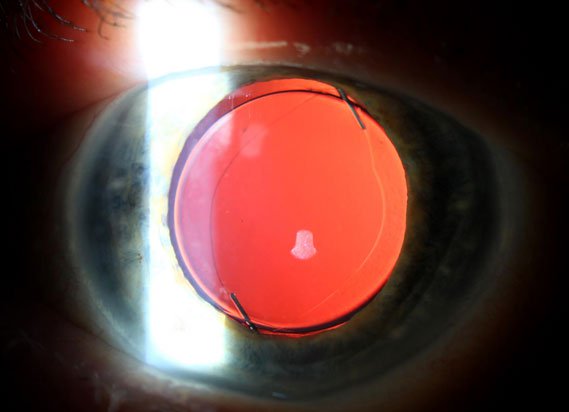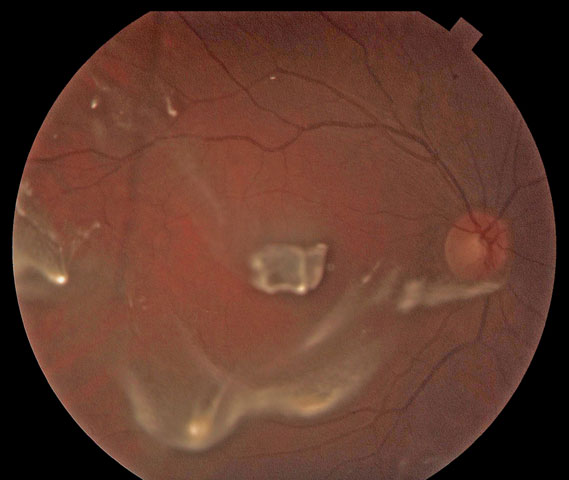BLOG: Learn the risks of capsular breaks
Like most technology, modern cataract surgery has developed as a result of multiple small evolutions that have culminated in a procedure so effective it is often viewed by patients as refractive surgery. Perhaps it is because of the high safety profile that it is the most frequently performed surgery in the U.S.
In hindsight, one of the most important of those innovations was the step of going from intracapsular cataract surgery (where the lens and the capsule are removed in one piece) to extracapsular cataract surgery (where the lens is removed whole from the capsule, but the capsule is left in place).
Most modern cataract surgery has moved beyond extracapsular to phacoemulsification, where the nucleus is pulverized within the eye rather than being taken out whole, which, in turn, allows for a smaller incision. However, the benefits of extracapsular surgery remain – reduced risk of severe retinal complications and a very stable place to put the implantable IOL – right back in the capsule. The reutilization of the capsule is often underappreciated in the optometric office, but when surgical complications compromise the capsular integrity, it can impact the patient’s surgical and postoperative course. The comanaging optometrist should have a passing familiarity with these changes and some of the additional associated jargon.
To fully appreciate how important a stable, intact capsule/zonular apparatus is in modern cataract surgery, we need to step back and look at what the capsule provides to the eye.
First, and most obviously, the capsular apparatus (which includes the capsule and zonules) allows a very safe, stable and long-lasting place to put an IOL. Assuming there are no zonular issues, an IOL placed in the capsule should be stable and not create any other problems throughout a patient’s life, regardless of their age at the time of surgery. Further, the latest generation of IOL calculation formulas are based on a capsular location of the IOL, and any change in position will require either recalculating for an anterior chamber (AC) IOL or using a fudge factor for adjusting to a sulcus-based IOL. As you might expect, a fudge factor is less accurate that a well-designed calculation.
The second, often underappreciated, benefit of the posterior capsule and zonules is their tectonic function. The capsular apparatus provides a mechanical barrier that, in concert with the anterior hyaloid face, prevents migration of the vitreous into the (AC). This is more important than it sounds. While vitreous in the AC may occasionally become a visual annoyance (in most cases patients don’t notice it) and more rarely may “wick” out of the postsurgical eye through a paracentesis port, it could lead to increased risk of infectious endophthalmitis.
In most cases, vitreous in the AC is not an issue in and of itself. Instead, it is the process of the vitreous moving into the AC rather than its presence within the AC that causes issues. As vitreous moves into the AC, we have a vitreal system that is stretched to fill a wider volume, leading to increased vitreoretinal traction and increased risk for pathology.
To summarize, an intact posterior capsule is critical to the refractive outcome, long-term stability of the eye and health of the eye. Unfortunately, a somewhat common intraoperative complication of cataract surgery involves a break in the posterior capsule, occurring in about 1.8% of cases (Ti, et al). Further, these patients have a 3.8 times greater rate of best spectacle-corrected visual acuity being worse than 20/40 compared to uneventful cases (Ionides, et al.).
Posterior capsular tears can occur at all points of surgery where the lens or the capsule is being manipulated: creation of the capsulorrhexis, phacoemulsification, removal of the cortex, polishing of the posterior capsule and insertion of the IOL. At the time of a posterior capsule tear developing, the surgeon is faced with a few questions that need to be answered: Was lens material dropped into the vitreous? Is the break large enough to compromise the stability of a standard in-the-bag IOL placement? and Should an anterior vitrectomy be performed?

If a large amount of lens material was dropped, the patient will almost certainly require a retinal consultation to retrieve it, as nuclear material will create a low-grade long-lasting inflammation, which increases risks of several complications.
If the break was large enough to compromise stability of the IOL, the surgeon has one of a few different choices when it comes to securing the IOL in the eye. An ACIOL is possible, but given long-term issues associated with their use – glaucoma and corneal decompensation – they are falling out of favor.
A posterior chamber sutured IOL is another option, but sutures will often break or cheese wire through tissue given enough time leading to poorer lens stability over time and a greater rate of refixation of the IOL.
A third option would be a technique known as scleral fixation, which involves threading the haptics through the scleral wall and gluing them into place. Scleral fixation is a technical, somewhat niche, surgery at this time, and not all surgeons are suited to perform it. Additionally, scleral fixation can lead to possible issues with external erosion of the haptics over time and tilt of the IOL, and long-term data on stability is lacking.
If the break of the capsule is too large to safely hold the IOL, but there is still a lot of intact capsule remaining, the final option a surgeon could employ is a technique called “optic capture.” In a case where optic capture is used, the haptics of the IOL are tucked into the ciliary sulcus – a technique insufficient to hold the lens alone, but from here, the optic of the IOL is buttonholed through the remaining anterior capsulorrhexis. In this way, the IOL has support from both the remaining viable capsule as well as the ciliary sulcus. While optic capture is inferior to a full “in-the-bag” IOL approach, it is often the next best thing in terms of stability, surgical complexity and risk of complication. If you see a patient who has had cataract surgery and you notice the capsulorrhexis is ovalized rather than circular, you can be pretty certain that the patient has optic capture. The rhexis ovalizes as a result of it stretching around the haptics, which, in this case, are the only part of the IOL left anterior to the capsule.
The final challenge facing the surgeon when they encounter a capsular tear is whether or not an anterior vitrectomy should be performed. Again, anterior vitreal migration increases vitreoretinal traction and, therefore, increases risk of both cystoid macular edema (CME) and retinal detachment. The surgeon can mitigate this risk somewhat by performing an anterior vitrectomy to ensure vitreal migration does not occur. Of course, this procedure has its own risks and, additionally, when a vitrectomy is performed, intravitreal triamcinolone is generally used to help visualize the vitreous. Some of this steroid is invariably left behind, in which case IOP issues and floater concerns may develop and persist for a couple of months as the steroid clears.

As you can see, even though there are surgical workarounds when a capsular break occurs, none provide the safety and stability of placing the IOL in the capsular bag. Barring patient complaints of floaters from triamcinolone, none of these surgical workarounds will make their presence known prior to a real issue (IOL dislocation, CME, retinal detachment) developing. Therefore, for patients who have experienced a surgical capsular tear, it’s important to be on alert for symptoms of associated problems: late reduction in vision indicating possible CME, assessing IOL placement and stability in the microscope with saccadic eye movements while dilated, listening closely to patient concerns that may indicate a retinal detachment and assessing IOP carefully in eyes that have had intravitreal steroid. As risk of complication rises in these eyes, it may be wise, depending on the specific case, to see the patient more frequently and to educate them more closely on concerning symptoms that should prompt a follow-up.
Finally, the eye has to be dilated to visualize the capsule, and even when dilated it can be difficult to fully assess a clear capsule. There is often an assumption that if the IOL is in the posterior chamber, it must be “in the bag.” Unfortunately, due to posterior capsular tears, which occur somewhat regularly, this is not always the case. Being aware of the risk of capsular breaks, the terminology used in the operative report and surgical workarounds to these breaks will allow the comanaging OD to communicate clearly with both the patient and surgery center and follow the patient on appropriate intervals.
References:
Ti SE, et al. Am J Ophthalmol. 2014;doi.org/10.1016/j.ajo.2013.08.022.
Ionides A, et al. Br J Ophthalmol. 2001;doi:10.1136/bjo.85.2.222.
